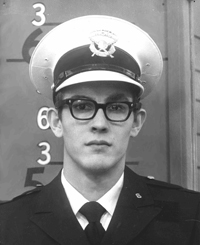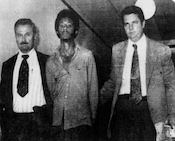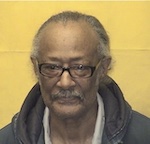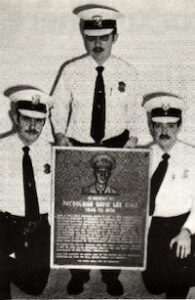Patrolman David Lee Cole | Cincinnati Police Division

Badge: P160
Age: 24
Served: 5 years
July 20, 1969 to July 17, 1974
THE OFFICER
Dave was born December 30, 1949 in Cincinnati, the first child born to James E. and Ruth (Evans) Cole. At the time, James was a mechanic for Fuller Manufacturing.
On April 15, 1953, when Dave was 3½ years old, his father joined the Cincinnati Police Division as a Police Recruit. He was promoted to Patrolman and assigned to District 6, Hyde Park.
Dave grew up in Amelia in Clermont County and attended Amelia High School where he participated in the Distributed Education Club, football, basketball, and intramurals and co-captained the Clermont County Champion Wrestling Team. He graduated in 1969.
By then, his father had served in District 7 (Walnut Hills), District 1 (downtown), and back to District 6. Patrolman Cole probably regaled his young son of high-speed pursuits, a car struck by a train, bank robbery arrests, foot chases, and all manner of exciting things that occur in the life of an active policeman.
One month after graduation, Dave joined the Cincinnati Police Division as a Police Cadet on July 20, 1969. While attending the University of Cincinnati, he served at Police Communications (1430 Martin Drive) and District 6 (3295 Erie Avenue). During August 1972, he graduated with an associate degree in Police Science.
On August 12, 1972, Dave married his high school sweetheart, Cheryl Haas, at St. Bernadette Church in Amelia.
On October 29, 1972, 19½ years after his father, Dave was appointed Police Recruit in Cincinnati’s 58th Recruit Class. His was the first recruit class started in the new police academy established in the north wing of the old Courter Technical High School building. The recruits were seated alphabetically. Recruit Dennis Bennington, Recruit Donald Burdsall, and Recruit Cole, seated together, would eventually start calling themselves the Three Musketeers. Within 6½ years, all three would be shot and killed in the line of duty.
Recruit Cole was promoted to Patrolman on February 25, 1973, issued Badge Number 160, and reassigned to District 6. Later in 1973, he joined the Ohio National Guard. For a short time, from October 1973 through March 1974, 20-year veteran, James Cole, and rookie, Dave Cole, served together in the same district. On March 31, 1974, Patrolman Dave Cole was rotated to District 7 (813 Beecher Street).
By July, he had served his community and country for almost 5 years. He and his young wife had just purchased a new home and he was considering gearing up to study for the next promotional examination for Police Sergeant.
Ordinarily an off day, on July 16th, at 11 p.m., Patrolman Davie Cole was sitting in 3rd Relief roll call because he had changed his off days to attend weekend drill with the National Guard.
THE KILLERS
Roland A. Reaves was the opposite side of the proverbial coin. He was born July 28, 1951, 1½ years after David Cole. His parents were either of Chicago or moved to Chicago after he was born.
While Recruit Cole was at the Training Academy, Reaves, at 20, had already amassed eight criminal convictions in Chicago and a history of beating his wife, Jeanette Reaves. On February 8, 1972, Reaves stole a taxicab, assaulted his wife one last time, locked her in the trunk of the taxi, and abandoned it and her in a remote spot. On that day, temperatures ranged from 12º to -4º. Chicago Police found the taxi and her frozen remains February 10, 1972.
Reaves was arrested March 16, 1972 and charged with her Murder. A judge dismissed the case on May 8, 1972 because Illinois Attorney General Henry V. Hanrahan failed to obtain a coroner’s report in time for the preliminary hearing. Chicago Police reinstated the charges on the same day. On May 11th, another judge dismissed the charge again, allegedly for another prosecutorial error, and released the murderer.
Chicago Police signed another warrant, but Reaves fled the state. Other than Detroit, his whereabouts for more than a year are not known, but sometime between February and July 1974, he came to Cincinnati and moved in with his sister, Connie Reaves and her boyfriend, Ricardo Woods, at 2035 Auburn Avenue.
Ricardo Augustus Woods was a month younger than Dave Cole, born January 10, 1950 in Stonewood, West Virginia to Johnny and Dorothy Woods. As an adult, he worked in construction and married. He traveled to where the work was; Stonewood, West Virginia, Florida, and Lima, Ohio. About the time Reaves was murdering his wife in 1972, Woods left his wife and moved to Cincinnati. About May 1974, he was laid off from another construction job.
Woods had no criminal record until he met Reaves. By mid-July, Reaves convinced Woods to purchase a .22 caliber semiautomatic pistol with his unemployment check. On July 16th, Reaves purchased a .38 Special revolver for $55.00. While Patrolman Cole was in roll call on July 16th, Reaves and Woods were planning to rob the United Dairy Farmers store at 2373 Florence Avenue.
INCIDENT
Less than two hours later, on July 17, 1974 at 12:46 a.m., Reaves was on top of the store’s roof, poised to ambush the clerk, Robert Leigh Smith, and take the night’s receipts. That he was more than willing to kill Smith is obvious.
Woods was the lookout.
Mrs. Fay Valle of 2413 Gilbert Avenue saw Reaves through her window and called the police with a report of a burglary at the store. Cincinnati Police Communications Center dispatched two patrol cars, including Patrolman Cole, and a Canine Unit.
But before the officers arrived, Reaves and Woods heard sirens from Fire Department apparatus responding to Park Avenue on an unrelated run. Fearing that they had been discovered, they headed down Florence Avenue. As Patrolman Terry Kramer arrived at the scene, he broadcast a description of two men walking down Florence Avenue. Not knowing if they were involved, or even if there had been an offense, he addressed the immediate concern at the store.
Patrolman Cole was rapidly responding to the store. He had heard the descriptions on his radio and that two patrol cars were on scene, so when he saw two men running down Florence Avenue, he skidded to a stop, ordered the men to come to him, and got out of his car. Woods walked toward him, and Reaves followed.
About 12:50 a.m., Reaves, concealed from Patrolman Cole by Woods’ body, pulled his .38 Special revolver. As they neared Patrolman Cole, Reaves, from behind Woods, ambushed him, shooting at him three times. One shot hit the police car near Patrolman Cole and fragmented into his face. Another struck his left hand and radio microphone, destroying it, and fragmented into his face. The other went into his chest and through his diaphragm, pancreas, and stomach. Patrolman Cole fell to the ground with terribly painful and life-threatening, but probably survivable, wounds. He fired four shots at his assailants as they ran further down Florence Avenue, but none took effect.
When Patrolman Cole stopped firing, Woods and Reaves saw him on the ground and Reaves convinced Woods, at gunpoint, to go back and shoot him again so that he could not “rat out” Reaves. With Reaves supervising, Woods shot Patrolman Cole again with two .22 copper-jacketed hollow point bullets. It is likely that the first shot went through Patrolman Cole’s left lip and shattered his mandible and that Patrolman Cole, in a defensive reaction, rolled over. The last shot went into his back, searing through both lungs, the pulmonary artery, and the systemic aorta. This shot collapsed his lungs and caused him bleed out.
Reaves then, according to a witness, yelled “a dirty, obscene word about how he’d kill all of the SOBs.”
Officers at the store heard the shots but could not see where they came from. Patrolman Richard Sizemore responded to the area and found Patrolman Cole barely alive and unable to talk.
After the shooting, Woods and Reaves ran through a wooded area beneath the Kenton Street Bridge, up to Gilbert Avenue, and then through the yards to a home of their friends, Ernie and Charlie Wyche, at 959 Nassau Street.
Reaves, revolver still in hand, told them how he pushed Woods out of the way and shot the officer. He also told them that he had to kill the officer because the officer could identify him. They changed their clothes, unloaded their handguns, and left. Later, Reaves bragged to his sister about having killed a police officer.
DEATH
Patrolman Schulte rushed Patrolman Cole to General Hospital, but Dr. R. Rooney declared him dead on arrival at 1:15 a.m.
Patrolman Cole was survived by his wife, Cheryl (Haas) Cole; parents, Cincinnati Patrolman James E. and Ruth Cole; and siblings, United States Air Force Airman Kenneth Cole, Connie Cole, James E. Cole, Jr., and Stephen Cole.
On the following day, the Fraternal Order of Police paid out to the widow $9,500 from their Death Benefit Club, of which Patrolman Cole was a member. The United Dairy Farmers gave her $5000. And the “100 Club” gave her $1000.
On July 19, 1974, 1000 people in 300 vehicles traveled from Cincinnati to E. C. Nurre Funeral Home in Amelia for his layout. The next morning, a huge procession formed at the Cincinnati Police Division Headquarters at 310 Lincoln Park Drive and drove to Amelia to escort his remains to their final resting place in St. Peter’s Cemetery in New Richmond.
INVESTIGATION
Following the shooting, police had no immediate suspects. Dozens of officers and canine searched and canvassed the area for several blocks. The Fraternal Order of Police posted a $1000 reward and the Fraternal Order of Police Association a $2500 reward for any information leading to the arrest and conviction of the suspects. The Cincinnati Enquirer also offered $2500 through their “Secret Witness Program”.
Sergeant Paul “Skip” Morgan commanded a squad of Homicide detectives dedicated to the task of investigating the offense, including Detectives Bernard Kersker, Thomas Gardner, Hank Snodderly, and Richard Burgess.
By Thursday morning, July 18, 1974, Police thought they were looking for as many as four suspects involved in the United Dairy Farmers offense and Patrolman Cole’s murder. More than 300 tips had been received at special phone numbers set up for that purpose. Additionally, at least 28 Tactical Unit and investigators were canvassing the area, knocking on doors, and talking to citizens.
 Their investigation led them to Reaves’ home on Auburn Avenue and, at 9:30 a.m., about 33¾ hours after the murder, detectives found and arrested Reaves and took him to the Criminal Investigation Section at 222 E. Central Parkway for interrogation. His arrest was kept secret until the next day. He admitted his participation, claimed self-defense, and implicated Woods and two others whom he supposedly knew only by their first names. He was also taken to the murder scene to give his account as to how the murder occurred.
Their investigation led them to Reaves’ home on Auburn Avenue and, at 9:30 a.m., about 33¾ hours after the murder, detectives found and arrested Reaves and took him to the Criminal Investigation Section at 222 E. Central Parkway for interrogation. His arrest was kept secret until the next day. He admitted his participation, claimed self-defense, and implicated Woods and two others whom he supposedly knew only by their first names. He was also taken to the murder scene to give his account as to how the murder occurred.
Detectives went to Woods’s uncle’s home and determined that Woods left town with Reaves’ sister on Wednesday afternoon and traveled to West Virginia in a pink Cadillac.
Also, on the morning of July 19, 1974, the Hamilton County Grand Jury indicted Woods and Reaves on three separate charges, each of which carried a possible death sentence: Murder While Escaping from Lawful Custody, Murder While Fleeing After Committing and Attempted Robbery, and Murder of a Law Enforcement Officer. Federal investigators signed a warrant for Unlawful Flight to Avoid Prosecution (UFAP) against Woods.
At 11:30 a.m., 35¾ hours after the murder, FBI, West Virginia State Police, and Harrison County Sheriff agents, officers, and deputies surrounded a white frame house belonging to Dorothy Barnett, Woods’ mother, in Stonewood, West Virginia. Inside, the found Woods, Connie Reaves, and Roland Reaves’ revolver. Woods had been sleeping and offered no resistance. He was arraigned in Marion County before U.S. Magistrate Frank J. DePond, pleaded not guilty on the UFAP warrant, and waived extradition back to Ohio.
On Saturday, July 20, 1974, Cincinnati Detectives Hank Snodderly and Frank Sefton drove to the Marion County Jail in Fairmont, West Virginia and questioned Woods. He gave a self-serving admission to the offense, and returned to Cincinnati with the detectives and Connie Reaves. He did not implicate the other supposed conspirators.
JUSTICE
On July 30, 1974 Presiding Judge Frank M. Gusweiler scheduled separate trials for Woods and Reaves to begin on October 15, 1974. The cases were prosecuted by the Hamilton County Prosecutor Simon L. Lies, Jr., and his Chief Assistant, Fred J. Cartolano. Judge Gusweiler appointed attorneys Thomas Stueve and Bernard J. Gilday, Jr. to defend Woods and Harry McIllwain and Jack Rubenstein to defend Reaves. The pair would be the first to be tried under the new charge of Aggravated Murder with a Police Officer specification requiring a sentencing of death. At least two of their attorneys were considered to be among the best in Cincinnati.
Woods waived a jury trial and on October 15, 1974 a three-judge panel of William R. Matthews, William S. Mathews, and Robert L. Black, Jr. tried the case. They convicted Woods on October 23, 1974 and sentenced him to die by electrocution on January 31, 1977. Because of a Supreme Court ruling during the late 1970s, his death penalty was commuted to life. Based on Ohio’s laws for “Life Imprisonment” he was brought before the Parole Board on September 2, 1994. No notice was given other than to the defendant and he was paroled to California having served less than 20 years after his conviction for putting the last two bullets, including the fatal one, into Patrolman Cole.
Though ending Patrolman Cole’s at the age of 24, Woods was permitted to live to 60 years, dying in 2010, living another 16 years as a free man.
Judge Frank M. Gusweiler presided over Reaves’s trial on October 15, 1974. Reaves interrupted the trial on numerous occasions and was, for a while, ejected from his own trial. A jury was sequestered on October 23, 1974 and the next morning returned a verdict of guilty for Reaves. It was then the legal requirement for Judge Gusweiler to determine if there were any mitigating circumstances to prevent a sentence of death. Ever defiant, Reaves asserted, “I want to be sentenced now. I don’t want any mitigation. He was also sentenced to die on February 1, 1977, which was also commuted.
 Notices of his parole hearings have been made public and the Parole Board has continuously rejected him after thousands of citizens voiced their protests. His latest hearing was March 17, 2017 and after thousands of letters were sent to the parole board and dozens of violations assessed against him in prison, his case was continued for ten years. His next hearing will be scheduled during 2027 when he is 75½ years old.
Notices of his parole hearings have been made public and the Parole Board has continuously rejected him after thousands of citizens voiced their protests. His latest hearing was March 17, 2017 and after thousands of letters were sent to the parole board and dozens of violations assessed against him in prison, his case was continued for ten years. His next hearing will be scheduled during 2027 when he is 75½ years old.
EPILOGUE
In the years prior to the killing, the Fraternal Order of Police and Police administrations debated with the city’s Mayor Theodore Berry and City Council regarding a need for 250 more police officers. Experts from the International Association of Chiefs of Police (IACP) determined that Cincinnati needed 200 more officers for maximum police efficiency.
The complement at the time was 1,132 officers and 218 civilians. After the murder, Councilman David Mann suggested hiring civilians to replace sworn officers for patrol duty. Three weeks following Patrolman Cole’s murder, City Manager E. Robert Turner, with the backing of Safety Director Henry Sandman and Police Chief Carl V. Goodin, submitted to City Council a plan to spend $400,000 for overtime to temporarily implement 38 two-man units. It was intended to be a temporary solution, permanency contingent upon a formal study into the matter. Than never happened.
Instead, after 29 months and three more officers’ murders – Sergeant Charles Handorf in 1974 and Police Officer William Loftin and Sergeant Robert Lally in 1975 – City Council laid off dozens of police cadets and, on December 6, 1976, laid off 124 police officers. After the death of Delhi Police Officer John Bechtol (one of those laid off) and murders of three more officers – Police Officers Charles Burdsall in 1978 and Robert Seiffert and Dennis Bennington in 1979 – most of the laid-off officers were recalled, but no new officers were hired before 1980; lay-offs occurred again and again; and eventually the complement was reduced to less than 900.
 A bronze plaque honoring Patrolman Cole, purchased through donations by sworn and civilian Police Division employees, was dedicated on May 12, 1975. Patrolmen Walter Barlag, Thomas Waller (later Vice President of the Greater Cincinnati Police Historical Society), and Stephen Hoerst coordinated the project and formerly presented it to the district commander, Captain James Stout. It was temporarily hung at District 7 (813 Beecher Street) and then transitioned to the new District 4 (4150 Reading Road) when District 7 was disestablished.
A bronze plaque honoring Patrolman Cole, purchased through donations by sworn and civilian Police Division employees, was dedicated on May 12, 1975. Patrolmen Walter Barlag, Thomas Waller (later Vice President of the Greater Cincinnati Police Historical Society), and Stephen Hoerst coordinated the project and formerly presented it to the district commander, Captain James Stout. It was temporarily hung at District 7 (813 Beecher Street) and then transitioned to the new District 4 (4150 Reading Road) when District 7 was disestablished.
During 1995, Captain Christopher Robertson, Training Section Commander, and Lieutenant Stephen R. Kramer, Assistant Planning Section Commander, discovered and researched a 1950 Cincinnati Municipal Code ordinance which authorized the retirement of badges of police officers who have died in the line of duty. Police Chief Michael C. Snowden subsequently retired Badge 160 and authorized the creation of a Cincinnati Police Memorial. Captain Robertson, Lieutenant Kramer, Sergeant Thomas Waller, and retired Police Officer James “Mike” Hillgrove planned, created, and established the memorial currently at the Cincinnati Police Training Academy.
Ricardo Woods was released from parole and returned to Cincinnati. He died, October 17, 2019, survived by a wife and three children – life pleasures not afforded to the man he murdered in 1974.
During September 2021, having been approved by Cincinnati City Council, Florence Avenue was honorarily and additionally named “David L. Cole Memorial Way.” A ceremony was held on September 10th which included a speech by Patrolman Cole’s wife, her unveiling the new sign at Florence Avenue and Reading Road, and a keynote speech by the Greater Cincinnati Police Historical Society’s President.
During December 2022, the Ohio Congress passed Ohio House Bill 578, introduced by Representative Cindy Abrams, to dedicate a portion of Interstate 71 as “Patrolman David L. Cole Memorial Highway.”
If you have information, artifacts, archives, or images regarding this officer or incident or any incident involving the death of a law enforcement officer, please contact the Greater Cincinnati Police Museum at Director@Police-Museum.org.
© This narrative was revised July 18, 2024 by Cincinnati Police Lieutenant Stephen R. Kramer (Retired), Greater Cincinnati Police Historical Society President, based on his research and that of Cincinnati Police Sergeant Thomas Waller (Retired), former Greater Cincinnati Police Historical Society Vice President, research by Cincinnati Police Officer Jeff Schare (Retired), and on personal recollections of the officer’s widow. All rights are reserved to them and the Greater Cincinnati Police Museum.